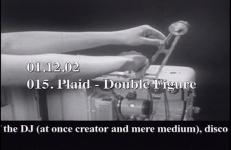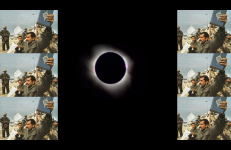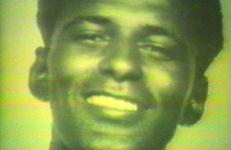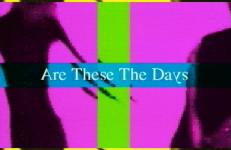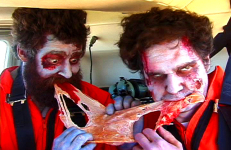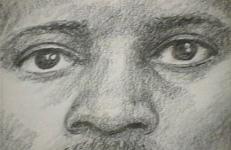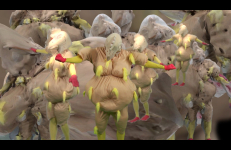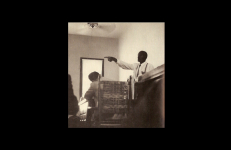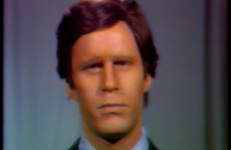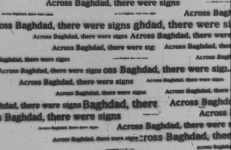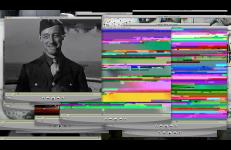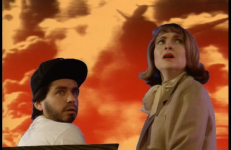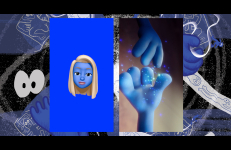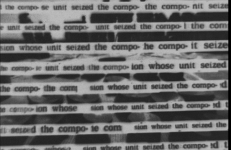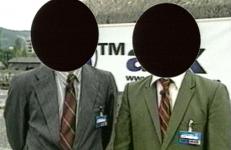1! is part of the Pop Manifestos series, a five video project realized in collaboration with Cokes' former students Seth Price and Damian Kulash, and originally conceived as part of a series for the conceptual band SWIPE. “I closed the Pop Manifestos series as originally conceived with 1! (2004) where I present the titles of 100 CDs I've valued most from the years 1997-2002 set to music composed by Michael Bell-Smith.
Media Analysis
Bracketed by the Fall of Berlin Wall and the Collapse of the World Trade Center, a decade that saw the ossification of the neoliberal project, the rise of third-wave feminism, the proliferation of digital media, and even, perhaps, the “end of history": postmodernism; the emergence of internet; the commercialization of gangsta rap, and independent film; AIDS activist; digital cinema; the Gulf War; rave and riot grrrl cultures; reality television; MTV. A new diagrammatic system.
2 Spirit Dreamcatcher Dot Com queers and indigenizes traditional dating site advertisements. Using a Butch NDN 'lavalife" lady (performed by director TJ Cuthand), 2 Spirit Dreamcatcher Dot Com seduces the viewer into 2 Spirit "snagging and shacking up" with suggestions of nearby pipeline protests to take your date to, and helpful elders who will matchmake you and tell off disrespectful suitors. It's the culturally appropriate website all single 2 Spirit people wish existed.
A Pilot For A Show About Nowhere is a two-channel video that examines the politics of television viewership, incorporating footage from a number of sources to create a plurivocal narrative.
Anthony Ramos' astute deconstruction of television news focuses on his part in the media coverage of President Jimmy Carter's 1977 declaration of amnesty for Vietnam draft evaders. Ramos, who had served an 18-month prison sentence for draft evasion, was interviewed by news reporter Gabe Pressman, whose film crew meets Ramos' video crew in a confrontation between technologies and sensibilities. At the time, some broadcast television news crews still used 16mm film, although the expensive transition to ENG (electronic news gathering) systems had begun in 1974.
"Ad Vice consists of a succession of colored projection surfaces with segments of text from the worlds of advertising, sport and popular culture. These projection surfaces in turn alternate with images of a rock band whose music continuously frames the whole. As regards form and content, the video looks like a commercial, an advertising spot for SWIPE country. The fast changing images, the continual music, and the starting and ending credits refer to it. The viewer is greeted with the words: welcome to SWIPE country... enjoy the sound... make contact...
The HalfLifers exhume cinema’s favorite incarnation of mindless, decaying mortality, the Zombie, in the hopes of breathing new life into this misunderstood figure. From a panel discussion in an old TV studio to a quarantined helicopter high above California’s rolling hills, these life-challenged entities walk, talk, and chew over some of the more difficult questions of this “whole linear birth-death system."
This title is also available on HalfLifers: The Complete History.
And They Came Riding Into Town on Black and Silver Horses looks at how media representations shape our perception of violence and violent crime, in effect creating racist stereotypes. Andrews suggests that the evidence against young Black men is gathered not at the scene of the crime, but at the scene of representation.
Two bizarrely costumed characters – a human ‘chicken’ in a fat suit, and an elaborate folksy creature called an ‘authenticity fetish’- meet and debate their plight. In an attempt to reconcile themselves with some unspecified trauma of mass biotechnoviolation, these two beings quiz one another in rhyme and animation on the origins and ontologies of their species. A sardonic meditation on the nefarious reality of intensive farming, Artificial Intelligence, and the perils of denying complexity.
Animated Contingencies is an animated documentary that looks at how sketches take the place of photography in courtroom settings. Andrews focuses on how two different representations, a photograph and a courtroom sketch, capture the moment Moses Wright, Emmett Till's uncle, pointed out Till's murders while on the witness stand at their trial. The work then examines the authority of photographic evidence and how animated representations can provide both visibility and anonymity in testimony and other contexts.
Employing footage from an obscure 8mm film trailer for Battle for the Planet of the Apes to highlight the unstable relationship between the real, historical past and the distant, imaginary future, this project revolves around a central question: Is alien-ness indeed the metaphor for the 20th Century as power relationships have been embodied within our subconscious? Is there a relationship between these forgotten formats and the discontinued political ideologies that they depict?
In the fall of 1974 Doug Hall and Jody Procter began to develop a presidential archetype, which they called "the Artist-President." Procter wrote the speeches that Hall delivered "presidentially" in performances. Over time, the character became more explicitIy based on JFK, requiring a makeup artist and a speaking style more recognizably Kennedy-esque. On November 22, 1975, members of T. R. Uthco (at the Anthology Film Archives in New York) and Ant Farm (at a church in San Francisco) simultaneously screened media from their reenactment of President Kennedy's assassination.
In the fall of 1974 Doug Hall and Jody Procter began to develop a presidential archetype, which they called "the Artist-President." Procter wrote the speeches that Hall delivered "presidentially" in performances. Over time, the character became more explicitIy based on JFK, requiring a makeup artist and a speaking style more recognizably Kennedy-esque. On November 22, 1975, members of T. R. Uthco (at the Anthology Film Archives in New York) and Ant Farm (at a church in San Francisco) simultaneously screened media from their reenactment of President Kennedy's assassination.
Animal Charm's Ashley seems to develop a conventional story about a modern mother and wife with typically modern desires. But the insertion of incongruous soap opera scenes soon ensures that the seductive images take on an absurd and oppressive charge. “The antiseptic cleanliness of the imagery has a superficial appeal, but begins to feel claustrophobic — or toxic — after prolonged exposure.”
This film was made from The New York Times newspaper articles. The semi-automated animation process resulted in sentence recombinations that sometimes made sense while randomly emphasizing certain words and images.
The computer animation was transferred to one 100ft roll of 16mm Tri-X reversal film and then hand-processed. The reversal negative is the original.
Producer/ Director: Sabine Gruffat
Hand Processing: Matthew Kelson
"Between the Lines is an exploration of what Muntadas terms the 'informational limits' of television—the selections, programs, decisions, edits, time schedules, image fabrications and so on—specifically addressing the means by which 'facts' in the network news are transmitted on television. Muntadas slows and examines the process, observing a newscaster’s exercise in assembling events, locating images, and constructing the news."
—Bob Riley, Currents: Mediated Narratives (Boston: Institute of Contemporary Art, 1984)
Big_Sleep™ explores problems in our archival urges. Via a single-channel desktop screencast, informatic elements ebb and flow—creating and relating interface absences. These gaps suggest that no amount of hard drive space can defy mortality.
Big_Sleep™ explores problems in our archival urges. Via a single-channel desktop screencast, informatic elements ebb and flow—creating and relating interface absences. These gaps suggest that no amount of hard drive space can defy mortality.
"Black Holes/Heavenly Bodies-Hell is a high-tech nightmare about a coming-of-age in America in which violence and mediocrity are the potent background noise." – Steve Seid
In this moment when the believability of our reality continues to stretch - blue people are hoping to enter into our reality environment.
In English, Chinese, Haudenosaunee, and Spanish. This video is originally a 2-channel video installation.
In this moment when the believability of our reality continues to stretch - blue people are hoping to enter into our reality environment.
In English, Chinese, Haudenosaunee, and Spanish. This video is originally a 2-channel video installation.
This film was made from The New York Times newspaper articles. The semi-automated animation process resulted in sentence recombinations that sometimes made sense while randomly emphasizing certain words and images.
The computer animation was transferred to one 100ft roll of 16mm Tri-X reversal film and then hand-processed. The reversal negative is the original.
Producer/ Director: Sabine Gruffat
Hand Processing: Matthew Kelson
Martha Rosler tackles mainstream media's representation of the case of surrogate mother Mary Beth Whitehead.
®™ark is an organization dedicated to bringing anti-corporate subversion and sabotage into the public marketplace. This updated video compilation includes a glitzy promotion for the ®™ark system (Bringing It All to You!); a behind-the-scenes look at some ®™ark propaganda efforts; an ®™ark PowerPoint presentation concerning "the Y2K bug”; a Danish television report about ®™ark and Hitler; a Boston news report about ®™ark; and, finally, the grand prize winner of ®™ark 1998 Corporate Poetry Contest, reading his winning entry.




